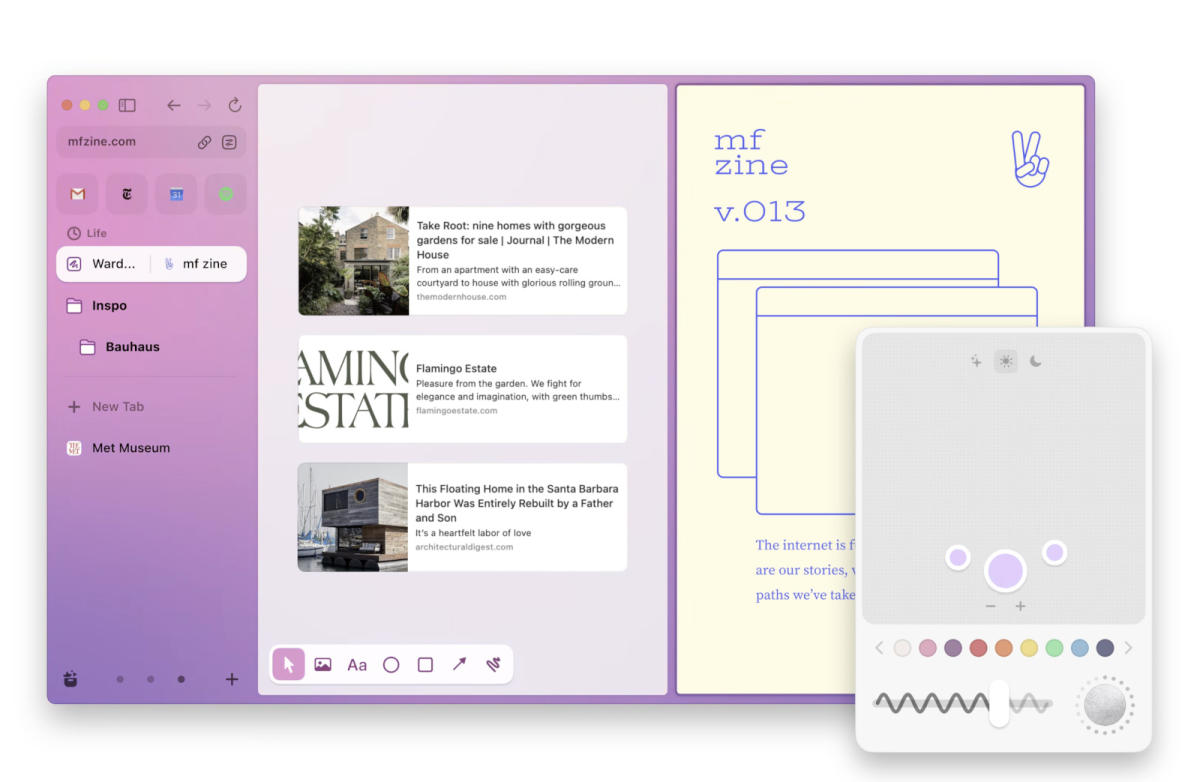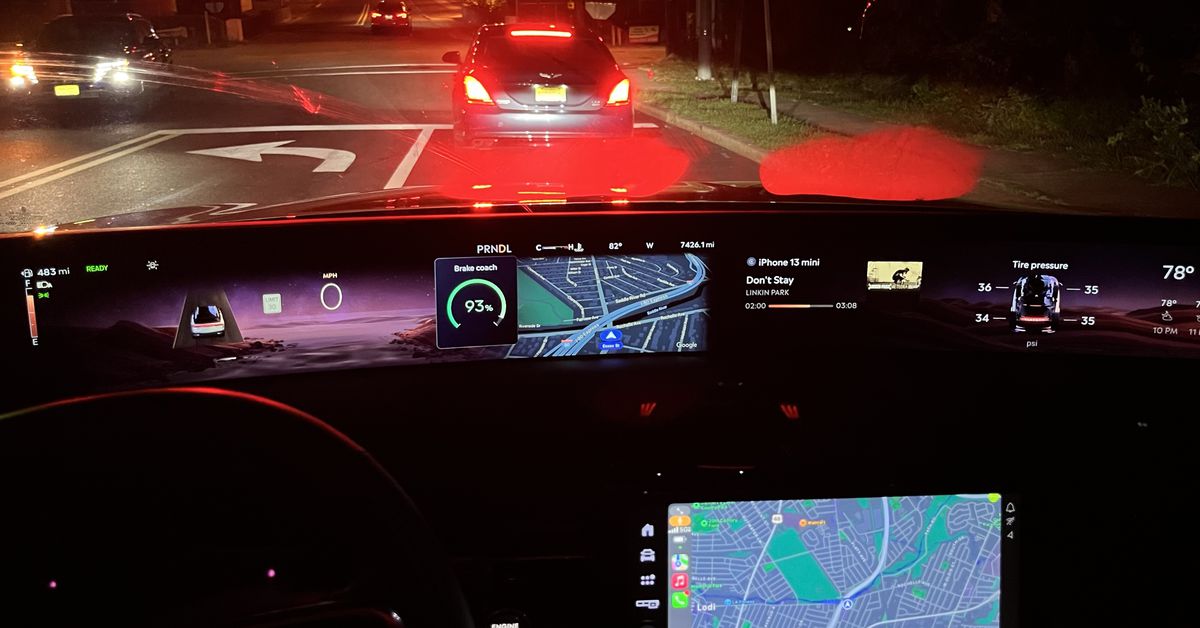I’m seeing double as I cruise down the highway in a 2024 Lincoln Nautilus, a hybrid-powered SUV under Ford’s luxury brand. I have Apple Maps running on the center touchscreen, projecting from my iPhone via Apple CarPlay. I’m also seeing the same map mirrored right above, taking up about a quarter of a massive display that spans the length of the dashboard.
Technology
HPE acquires Morpheus Data, bolstering hybrid cloud offering

Hewlett Packard Enterprise is acquiring Morpheus Data to simplify hybrid and multi-cloud management. The technology will be integrated into HPE’s GreenLake as the vendor pursues AI workloads.
Spun out of Bertram Labs in 2015, Morpheus Data offers a multi-tenant hybrid cloud management platform with self-service provisioning, automation and FinOps capabilities. Bertram Labs is a wholly owned subsidiary of private equity firm Bertram Capital Management. Terms of the deal were not disclosed; the acquisition is expected to be completed before the end of October.
HPE has partnered with Morpheus for years to address hybrid cloud management issues, such as complexity, skill gaps and cloud sprawl. HPE will integrate Morpheus Data’s management and automation capabilities into its hybrid cloud platform GreenLake. This is HPE’s second hybrid IT management acquisition in the last 17 months. In March 2023, it acquired OpsRamp, which monitors and manages hybrid IT infrastructure.
There is a strategic fit between what Morpheus does and what HPE is trying to do with GreenLake, according to Matthew Eastwood, an analyst at IDC.
“There is this real battle for relevance today with respect to AI workloads,” he said. “Most, myself included, see hybrid as the operating model for AI workloads.”
As AI workloads become more common for enterprises, vendors such as HPE need to differentiate their offerings and look for opportunities, Eastwood said. For HPE, that means focusing on its storage, data management and networking capabilities in a hybrid IT environment, he said.
Alongside its acquisition of OpsRamp, Morpheus Data will add to HPE’s management and monitoring stack for hybrid IT infrastructure in a way that’s complementary, according to Hang Tan, senior vice president and chief operating offering of hybrid cloud at HPE.
“Morpheus is more on the OS and above management, and OpsRamp is more OS and below management,” he said. Tan added that OpsRamp can monitor and automate the infrastructure, while Morpheus can do the same for different hybrid services and spending options. Matt Kimball, an analyst at Moor Insights & Strategy, said he also believes the Morpheus acquisition could bring simplicity to GreenLake users by delivering a point-and-click experience in a single console for self-service, consumption, management and spend.
“I can tell you as somebody who spent a few years in IT management — complexity is the enemy of IT,” Kimball said.
While there is some overlap between the two acquisitions, Morpheus also brings additive capabilities to OpsRamp, Kimball said.
“HPE can leverage IP from both solutions to build out that uber infrastructure, operations/AIOps and cloud management platform,” he said. HPE said it expects to make employment offers to most Morpheus employees.
Morpheus will continue to be offered as a standalone product separately from GreenLake. Pricing for the standalone product or pricing changes for GreenLake have not been determined.
The downstream effect for Morpheus customers that compete with HPE is yet to be seen, Eastwood said. Dell, for instance, also partners with Morpheus, offering Multi-Cloud Management with Morpheus to its customers.
“[Competitors] will increasingly look for either their own technology or partner technology that they can use to steer future customers in a different direction,” he said. A potential downside might arise if HPE closes off Morpheus support for non-HPE customers, but that doesn’t seem likely, Kimball said. Morpheus offers support across platforms and clouds, and this aligns with HPE’s goal of supporting hybrid and multi-cloud infrastructures, he said.
“Apps and data live everywhere and move from on prem to off prem, and from cloud to cloud,” Kimball said. “GreenLake enables this, the HPE software stack supports this, and acquisitions like Morpheus enable the seamless integration and management of that environment.”
Adam Armstrong is a TechTarget Editorial news writer covering file and block storage hardware and private clouds. He previously worked at StorageReview.
Shoring up GreenLake
Morpheus customers and employees
Technology
NYT Mini Crossword today: puzzle answers for Sunday, September 22


The New York Times has introduced the next title coming to its Games catalog following Wordle’s continued success — and it’s all about math. Digits has players adding, subtracting, multiplying, and dividing numbers. You can play its beta for free online right now.
In Digits, players are presented with a target number that they need to match. Players are given six numbers and have the ability to add, subtract, multiply, or divide them to get as close to the target as they can. Not every number needs to be used, though, so this game should put your math skills to the test as you combine numbers and try to make the right equations to get as close to the target number as possible.
Players will get a five-star rating if they match the target number exactly, a three-star rating if they get within 10 of the target, and a one-star rating if they can get within 25 of the target number. Currently, players are also able to access five different puzzles with increasingly larger numbers as well. I solved today’s puzzle and found it to be an enjoyable number-based game that should appeal to inquisitive minds that like puzzle games such as Threes or other The New York Times titles like Wordle and Spelling Bee.
In an article unveiling Digits and detailing The New York Time Games team’s process to game development, The Times says the team will use this free beta to fix bugs and assess if it’s worth moving into a more active development phase “where the game is coded and the designs are finalized.” So play Digits while you can, as The New York Times may move on from the project if it doesn’t get the response it is hoping for.
Digits’ beta is available to play for free now on The New York Times Games’ website
Technology
Pixel 9 Pro Fold’s charging speed is the slowest among the series
Google unveiled the Pixel 9 Pro Fold alongside Pixel 9, Pixel 9 Pro, and Pixel 9 Pro XL last month. For those unaware, the Pixel 9 Pro Fold is the successor of last year’s Google Pixel Fold. Undoubtedly, Google has done a pretty good job with the second iteration of its foldable device. However, like any other smartphone, it isn’t perfect. The Pixel 9 Pro Fold has downsides which are now being noticed, with one related to its charging speed.
The Google Pixel 9 Pro Fold has the slowest wired charging speed of the series
The Google Pixel 9 Pro Fold reportedly has the slowest charging speed compared to other phones from the series. Today, Google confirmed 9to5Google that the Pixel 9 Pro Fold charging speed maxes out at 21W with the wired cable. Google hinted at the maximum power input received by the device based on the charging test carried out by its 45W charger.
That also means the Pixel 9 Pro Fold won’t receive any faster power input than 21W, even if you use a powerful charger. Well, the charging speed we are talking about here for the Pixel 9 Pro Fold is the same as the three-year-old Pixel 6. Surprising, right? Fortunately, this is not the case with other phones from Pixel 9 series.
In fact, all others got some generous charging speed boost from Google. For example, the Pixel 9 Pro XL has a capped wired charging limit of 37W. On the other hand, Google has slightly increased the charging speed on the Pixel 9 and Pixel 9 Pro compared to their predecessors.
Wireless charging capabilities aren’t good either
Are you thinking about wireless charging speed? The Pixel 9 Pro Fold disappoints in that aspect too. It comes with a maximum Qi wireless charging speed of just 7.5W. What’s worse, Google recently confirmed that the Pixel 9 Pro Fold doesn’t work with the Pixel Stand too. Earlier this month, multiple reports hinted that it could be the reason why Google pulled the Pixel Stand 2 from the online Google Store.
All that said, if you want first-hand Android experience on a foldable with good battery life, the Pixel 9 Pro Fold is the right choice for you. However, if you are someone who is a fan of fast charging, this year’s foldable may not please you. But again, are you willing to give up on other aspects just for fast charging? Well, we’ll leave it up to you.
Technology
New Snowflake service enables secure AI, ML deployment

Snowflake on Thursday made Snowpark Container Services generally available to enable customers to securely deploy and manage models and applications, including generative AI, within the vendor’s environment.
First unveiled in preview in June 2023, Snowpark Container Services is a fully managed service now available in all AWS commercial regions and in public preview in all Azure commercial regions.
Containers are a type of software that can be used to isolate applications for secure deployment. Snowflake’s new feature enables customers to use containers to manage and deploy any type of model, but they are optimal for generative AI applications because they enable customers to safely join large language models (LLMs) and other generative AI-powered tools with their data, according to Jeff Hollan, Snowflake’s head of applications and developer platform.
Given its role in helping user develop AI tools, Snowpark Container Services’ launch builds on Snowflake’s recent moves to customers with an environment for developing generative AI models and applications, according to Mike Leone, an analyst at TechTarget’s Enterprise Strategy Group.
Sridhar Ramaswamy took over as Snowflake’s CEO in February when Frank Slootman stepped down after five years of leadership that included guiding Snowflake through a record-setting initial public stock offering. Since then, the vendor has aggressively added generative AI-related capabilities such as launching its own LLM, integrating with Mistral AI and tools to enable users to quickly create AI chatbots.
“There has definitely been a concerted effort to enhance Snowflake’s capabilities and presence in the market when it comes to AI and, more recently, GenAI,” Leone said. “Offerings like Snowpark are helping AI stakeholders like data scientists and developers use the languages they prefer.”
As a result of what it adds, Snowpark Container Services is a significant new feature for Snowflake customers, he continued.
“It’s a big deal for the Snowflake ecosystem,” Leone said. “By being able to easily deploy and manage containers right in the Snowflake platform, it helps customers more easily handle complex workloads and keeps things consistent across development and production stages.”
“While Snowflake Container Services provides developers a secure environment, it was revealed in May that the log-in credentials of potentially 160 customers had been stolen and used to gain access to their data, although the vendor has stated it has not found any evidence that the infiltration resulted from a vulnerability, misconfiguration or breach of the Snowflake platform.
Technology
The Arc browser that lets you customize websites had a serious vulnerability

One of the feature that separates the Arc browser from its competitors is the ability to customize websites. The feature called “Boosts” allows users to change a website’s background color, switch to a font they like or one that makes it easier for them to read and even remove an unwanted elements from the page completely. Their alterations aren’t supposed to be be visible to anyone else, but they can share them across devices. Now, Arc’s creator, the Browser Company, has admitted that a security researcher found a serious flaw that would’ve allowed attackers to use Boosts to compromise their targets’ systems.
The company used Firebase, which the security researcher known as “xyzeva” described as a “database-as-a-backend service” in their post about the vulnerability, to support several Arc features. For Boosts, in particular, it’s used to share and sync customizations across devices. In xyzeva’s post, they showed how the browser relies on a creator’s identification (creatorID) to load Boosts on a device. They also shared how someone could change that element to their target’s identification tag and assign that target Boosts that they had created.
If a bad actor makes a Boost with a malicious payload, for instance, they can just change their creatorID to the creatorID of their intended target. When the intended victim then visits the website on Arc, they could unknowingly download the hacker’s malware. And as the researcher explained, it’s pretty easy to get user IDs for the browser. A user who refer someone to Arc will share their ID to the recipient, and if they also created an account from a referral, the person who sent it will also get their ID. Users can also share their Boosts with others, and Arc has a page with public Boosts that contain the creatorIDs of the people who made them.
In its post, the Browser Company said xyzeva notified it about the security issue on August 25 and that it issued a fix a day later with the researcher’s help. It also assured users that nobody got to exploit the vulnerability, no user was affected. The company has also implemented several security measures to prevent a similar situation, including moving off Firebase, disabling Javascript on synced Boosts by default, establishing a bug bounty program and hiring a new senior security engineer.
Technology
She sat down during the COVID lockdown and started coding — now she’s taking on Bolt

Sitting in Athens during the first COVID-19 lockdown, entrepreneur Rania Lamprou watched online e-commerce exploding because of social distancing. But merchants still struggled with low conversion rates because their checkout processes were complicated, and they had to integrate multiple providers for payments, shipping, and loyalty programs.
“I knew there had to be a better way to reduce friction for both merchants and customers,” Lamprou told TechCrunch. So, she thought, why not turn the checkout process into a “checkout-as-a-service” platform that streamlined it for both merchants and shoppers? She started coding in Python.
But, she wasn’t alone. Tech giants Shop Pay and Bolt were in the same space, but were focusing on the U.S. market. Europe was less of a focus. Shop Pay, for example, had started back in 2014 and has now raised a total of $982.1 million. So what was Lamprou going to do with her tiny startup, which she’d named Simpler?
She brought on two friends she’d known from university, Alex Kyriakopoulos and Spyros Mandekis, started building the team, and they raised their first $1 million pre-seed round.
Today, Simpler has over 250 merchants, more than half-a-million registered shoppers, and expects to increase its revenue by 10 times by the end of 2025, said Lamprou. It recently also raised €9 million (about $10 million) in a pre-Series A round to double down in the U.K., Italy and Spain. Participating in the round were VentureFriends, MMC Ventures and Lamda Development.
“Yes, Bolt is a big, massive company, but they are focused on the U.S., mostly with handling fraud problems, like chargebacks. That is a very big problem in the U.S., but it’s not so much in Europe,” she said.
In Europe, she said, there are different issues: “We have to localize and add all these different solutions, different providers. Every country has different needs, customer preferences, different payment providers, loyalty coupons, etc.”
That’s important because European e-commerce sales increased 66% from 2019 to 2021. Despite a temporary decline, the market is expected to keep growing, potentially reaching $955 billion by 2028.
The solution turned out to be elegant.
On Simpler, merchants can outsource payments, shipping and loyalty programs into one system, which, the company says, boosts conversions and reduces complexity. For shoppers, it means a one-click buying experience across multiple stores and channels.
“We’re seeing strong demand from both SMEs and enterprise-level businesses,” she said.
While Shop Pay is exclusive to Shopify, Simpler is designed for all platforms. And, unlike Bolt, which focuses heavily on the U.S. market, Simpler is targeting the U.K. and Europe.
“We’ve built a robust end-to-end solution with three orders of magnitude less funding than Bolt,” she added.
Technology
Ford’s new Digital Experience brings Android and Apple into balance

That screen is the 48-inch Panoramic Display, which runs on Android Automotive OS, Google’s native vehicle platform (not to be confused with the phone projecting Android Auto). It merges what’s actually two pieces of curved glass in a mesmerizing and cinematic fashion, combining the instrument cluster with infotainment and some widgets. In the Nautilus, the whole system is called the “Lincoln Digital Experience.”
But like most modern cars, former physical controls are being sucked into the digital world of the screen. To adjust airflow, I have to do the thing that many drivers dread doing: switching out of CarPlay navigation to the car’s native interface. But to my delight, as the Lincoln’s onscreen draggable digital airflow adjustment controls take over the 11.1-inch central display, Apple Maps continues to run on the Panoramic Display above.
To my delight, Apple Maps continues to run on the Panoramic Display
I start to get it. Most cars take an either-or approach with native-vs-projected operating systems. A few vehicles, like the Polestar 2, can also project Apple Maps to its instrument cluster screen. But the Lincoln’s larger, uncrowded pano display elevates the experience to the next level.
Some automakers today are in a tug of war with Apple and Google because drivers are in love with their phones and prefer to use their mobile device’s interface over the car’s factory offering. Some manufacturers have made the controversial decision to either discontinue phone projection (GM) or never add it in the first place (Rivian and Tesla). But Ford is staking out a different position: it thinks it can do both.
And to the company’s credit, I think it works. Ford is embracing customer choice, and the new Nautilus provides what I think is the best balance of phone mirroring and built-in software that we’ve seen yet.
Three years in the making
Ford’s been working on its new infotainment system for a few years now, in a search for the optimal software provider that has taken the company from Microsoft to Blackberry — and now to Google. Ford and Google struck a six-year deal in 2021 to bring Android Automotive inside “millions” of vehicles, and the Lincoln Nautilus is the first to feature the fruits of that deal.
The partnership meant Ford would use Google as its cloud provider for its connected vehicle services, promising features like Google Assistant voice control to change climate settings, automotive-approved Android apps, and over-the-air software updates.
Android gives Ford “a chance to really have a stable platform”
In an interview on Decoder, Ford CEO Jim Farley said he’d only want his teams working on navigation software if it were better than the one on smartphones. “An Android or a Google Automotive Services gives us a chance to really have a stable platform,” Farley said.
Ford is now rolling out its new Android-based “Digital Experience” across its vehicle lineup. The company’s strategy is to go big with screens in the luxury segment and pare things back in vehicles like the 2025 Explorer — while also balancing its still-supported but comparatively slow QNX-based Sync 4 system, like in the 2024 Maverick.
The computer on wheels is a smartphone
Overall, Lincoln’s Digital Experience has me believing that automakers are finally able to deliver competent and intuitive infotainment. That said, I’m still connecting my iPhone. After all, that’s kind of the point.
I get a seamless transition from Google Maps on both the center and pano screens to Apple Maps via CarPlay. I enter and exit the vehicle multiple times, and most of the time, everything immediately connects, save for some limited blacked-out center screen delays, especially when connected wirelessly. I have similar success with my Google Pixel 8 Pro projecting to the Nautilus via Android Auto. It’s kind of funny seeing Google Maps and Assistant replacing, well, Google Maps and Assistant.
My expectations are usually low with in-car software. But the Nautilus feels more like a capable, high-end Android device — and it even has Google Play Store apps. The usual suspects like Spotify and YouTube were already preinstalled, and I try a game called Asphalt Nitro 2, which performs well on the touchscreen as I swipe an autopiloting racecar in different directions. (I didn’t try playing with a Bluetooth game controller, but it’s supported.)
Games and streaming video apps only work while parked, and in the Nautilus, it works on the center touchscreen, but not on the pano display. Lincoln is including a new “pano mode” in the 2025 Navigator where games and video can work on either side of the big screen, but this function isn’t available in the Nautilus. And not all Google Play Store apps are there; I can’t download Netflix during my testing, but Amazon’s Prime Video is available, and I watched some Shah Rukh Khan Bollywood classics. (I forgot to log out, so enjoy the free movies, Lincoln.)
I played some music from Sirius XM radio and from my phone, and the 28-speaker Revel Ultima 3D audio system sounds great. The music widget on the right of the pano display displays album art, and you can control the music with a nifty touchpad on the steering wheel (although, sometimes, your thumb can slip and select the wrong item on the onscreen grid, kind of like swiping on an Apple TV remote).
There’s also Google Assistant, which can accept voice commands to change car settings like in-cabin temperature but couldn’t accept simple navigation requests for some reason. Lincoln communications manager Anika Salceda-Wycoco later tells me that it was a mistake on their part because they used the same Google account across multiple cars in the fleet, and it disabled the function.
Tesla lets you type while driving but Ford doesn’t
Regardless, voice would be your only option to change destinations on the move, as the onscreen keyboard does not pop up unless you’re parked. Annoyed, I pulled over and manually typed the address to my second destination on this trip. I’ve gotten used to my Tesla Model 3’s interface, where my wife could type the address on the screen for me while in motion — but that’s not possible in the Nautilus. Siri worked fine in CarPlay mode, but I can’t ask it to do things like turn on my AC seats.
2024 tech most of the time
But not all is chummy between the Lincoln and the smartphone interfaces. They do sometimes abruptly snatch each other onscreen. For instance, calling up Google Assistant while CarPlay is running creates an ugly transition to the built-in Lincoln interface. Same for when you’re in the Lincoln interface and you’re suddenly back in CarPlay when a text message comes. The upside is I have little issue wirelessly switching from CarPlay to Android Auto. A quick jump into Bluetooth settings lets me switch between my iPhone 13 Mini and Pixel 8 Pro without hassle, which has not been my experience in other vehicles.
Coming from Tesla’s Autopilot, which flashes a blue screen when you’re not paying attention, activating BlueCruise was a little startling. After I swiped my thumb on the steering wheel’s left touchpad and selected the corresponding box for BlueCruise on the onscreen grid, the Lincoln’s instrument cluster went all blue — sharply out of sync with the tranquil theme elsewhere on the pano display.
Lincoln’s menus on the touchscreen, however, work like a breeze, with gorgeous animations running in Epic’s Unreal Engine and a powerful processor with capabilities that clearly match some gaming Android phones.
Even with all the processing power, Lincoln’s not doing too much. You’re not getting a super detailed interactive 3D model of the Nautilus you can spin around like Tesla does with its Cybertruck or colorful illustrations like inside a Rivian. But you get tasteful and swift transitions, a cool 3D whirlwind animation of passenger seats showing who hasn’t buckled up, and a futuristic PS5 aura-looking theme on the pano display.
It surprises me that the huge pano display isn’t too information-dense, and I never feel overwhelmed or annoyed with the placement of things like the fuel bar, speedometer, transmission mode, or remaining mileage (which, by the way, is often quite a lot — the Nautilus went almost 500 miles for me on one tank). And Lincoln put the display high enough that I find it less distracting than some heads-up displays I’ve seen. For some reason, though, when you accelerate, a wavy mana-looking bar increases horizontally, which almost feels like a challenge to go faster.
Beyond the screen
The real reason anyone should look at the Nautilus is the amazing pano display. The future of cars is certainly all in the software, and it feels like Ford has a good thing going, striking the best balance yet between in-car infotainment and the popular phone-based systems that most people prefer. I was pretty much sold as soon as I opened the door and it introduced me to a full Nautilus intro animation on the pano display, with waves animating to the sides and timely light streaks on the door.
The screens work well enough, but not everyone wants them. Surveys have shown growing customer dissatisfaction with in-car tech, especially touchscreen software. People are overwhelmed, and Ford’s response seems to be to add more screens, which is not a guarantee for success. I have personally owned a 2014 Lincoln MKZ hybrid and consider myself tech-savvy. Longtime Lincoln fans who appreciate more physical controls (or at least dedicated touch buttons) on previous generation models, however, could find the digital experience too overwhelming for their taste.
But if they’re not, and Lincoln customers go gaga over the new screens, Ford could have stumbled on the right formula to make it, Apple, and Google all equal winners in the race to control the in-car experience.
-

 News4 days ago
News4 days agoYou’re a Hypocrite, And So Am I
-

 Sport3 days ago
Sport3 days agoJoshua vs Dubois: Chris Eubank Jr says ‘AJ’ could beat Tyson Fury and any other heavyweight in the world
-

 CryptoCurrency3 days ago
CryptoCurrency3 days agoEthereum is a 'contrarian bet' into 2025, says Bitwise exec
-

 Science & Environment4 days ago
Science & Environment4 days agoHow to unsnarl a tangle of threads, according to physics
-

 CryptoCurrency3 days ago
CryptoCurrency3 days agoDorsey’s ‘marketplace of algorithms’ could fix social media… so why hasn’t it?
-

 CryptoCurrency3 days ago
CryptoCurrency3 days agoDZ Bank partners with Boerse Stuttgart for crypto trading
-

 Science & Environment3 days ago
Science & Environment3 days ago‘Running of the bulls’ festival crowds move like charged particles
-

 News3 days ago
News3 days agoIsrael strikes Lebanese targets as Hizbollah chief warns of ‘red lines’ crossed
-

 CryptoCurrency3 days ago
CryptoCurrency3 days agoBitcoin miners steamrolled after electricity thefts, exchange ‘closure’ scam: Asia Express
-

 CryptoCurrency3 days ago
CryptoCurrency3 days agoRedStone integrates first oracle price feeds on TON blockchain
-

 CryptoCurrency3 days ago
CryptoCurrency3 days agoLow users, sex predators kill Korean metaverses, 3AC sues Terra: Asia Express
-

 CryptoCurrency3 days ago
CryptoCurrency3 days agoBitcoin bulls target $64K BTC price hurdle as US stocks eye new record
-

 CryptoCurrency3 days ago
CryptoCurrency3 days agoVitalik tells Ethereum L2s ‘Stage 1 or GTFO’ — Who makes the cut?
-

 CryptoCurrency3 days ago
CryptoCurrency3 days agoBlockdaemon mulls 2026 IPO: Report
-

 Health & fitness4 days ago
Health & fitness4 days agoThe secret to a six pack – and how to keep your washboard abs in 2022
-

 CryptoCurrency3 days ago
CryptoCurrency3 days agoCardano founder to meet Argentina president Javier Milei
-

 CryptoCurrency3 days ago
CryptoCurrency3 days agoCertiK Ventures discloses $45M investment plan to boost Web3
-

 CryptoCurrency3 days ago
CryptoCurrency3 days agoVonMises bought 60 CryptoPunks in a month before the price spiked: NFT Collector
-

 CryptoCurrency3 days ago
CryptoCurrency3 days agoSEC asks court for four months to produce documents for Coinbase
-

 CryptoCurrency3 days ago
CryptoCurrency3 days ago‘No matter how bad it gets, there’s a lot going on with NFTs’: 24 Hours of Art, NFT Creator
-

 Science & Environment3 days ago
Science & Environment3 days agoQuantum ‘supersolid’ matter stirred using magnets
-

 Sport3 days ago
Sport3 days agoUFC Edmonton fight card revealed, including Brandon Moreno vs. Amir Albazi headliner
-

 Science & Environment3 days ago
Science & Environment3 days agoHyperelastic gel is one of the stretchiest materials known to science
-

 Science & Environment3 days ago
Science & Environment3 days agoHow one theory ties together everything we know about the universe
-

 Science & Environment3 days ago
Science & Environment3 days agoSunlight-trapping device can generate temperatures over 1000°C
-

 Science & Environment3 days ago
Science & Environment3 days agoLiquid crystals could improve quantum communication devices
-

 Science & Environment3 days ago
Science & Environment3 days agoHow to wrap your mind around the real multiverse
-

 Science & Environment3 days ago
Science & Environment3 days agoPhysicists are grappling with their own reproducibility crisis
-

 Science & Environment3 days ago
Science & Environment3 days agoNuclear fusion experiment overcomes two key operating hurdles
-

 CryptoCurrency3 days ago
CryptoCurrency3 days ago‘Silly’ to shade Ethereum, the ‘Microsoft of blockchains’ — Bitwise exec
-

 CryptoCurrency3 days ago
CryptoCurrency3 days agoEthereum falls to new 42-month low vs. Bitcoin — Bottom or more pain ahead?
-

 CryptoCurrency3 days ago
CryptoCurrency3 days agoETH falls 6% amid Trump assassination attempt, looming rate cuts, ‘FUD’ wave
-

 CryptoCurrency3 days ago
CryptoCurrency3 days agoCoinbase’s cbBTC surges to third-largest wrapped BTC token in just one week
-

 CryptoCurrency3 days ago
CryptoCurrency3 days agoBitcoin options markets reduce risk hedges — Are new range highs in sight?
-

 Politics4 days ago
Politics4 days agoTrump says he will meet with Indian Prime Minister Narendra Modi next week
-

 Science & Environment3 days ago
Science & Environment3 days agoWhy this is a golden age for life to thrive across the universe
-

 Technology3 days ago
Technology3 days agoiPhone 15 Pro Max Camera Review: Depth and Reach
-

 Science & Environment3 days ago
Science & Environment3 days agoMaxwell’s demon charges quantum batteries inside of a quantum computer
-

 Science & Environment3 days ago
Science & Environment3 days agoQuantum forces used to automatically assemble tiny device
-

 News3 days ago
News3 days agoBrian Tyree Henry on voicing young Megatron, his love for villain roles
-

 Science & Environment4 days ago
Science & Environment4 days agoTime travel sci-fi novel is a rip-roaringly good thought experiment
-

 Technology4 days ago
Technology4 days agoWould-be reality TV contestants ‘not looking real’
-

 Science & Environment3 days ago
Science & Environment3 days agoITER: Is the world’s biggest fusion experiment dead after new delay to 2035?
-

 Science & Environment3 days ago
Science & Environment3 days agoQuantum time travel: The experiment to ‘send a particle into the past’
-

 CryptoCurrency3 days ago
CryptoCurrency3 days ago2 auditors miss $27M Penpie flaw, Pythia’s ‘claim rewards’ bug: Crypto-Sec
-

 CryptoCurrency3 days ago
CryptoCurrency3 days ago$12.1M fraud suspect with ‘new face’ arrested, crypto scam boiler rooms busted: Asia Express
-

 Science & Environment3 days ago
Science & Environment3 days agoWhy we need to invoke philosophy to judge bizarre concepts in science
-

 CryptoCurrency3 days ago
CryptoCurrency3 days agoBitcoin price hits $62.6K as Fed 'crisis' move sparks US stocks warning
-

 CryptoCurrency3 days ago
CryptoCurrency3 days agoBeat crypto airdrop bots, Illuvium’s new features coming, PGA Tour Rise: Web3 Gamer
-

 CryptoCurrency3 days ago
CryptoCurrency3 days agoMemecoins not the ‘right move’ for celebs, but DApps might be — Skale Labs CMO
-
Politics3 days ago
The Guardian view on 10 Downing Street: Labour risks losing the plot | Editorial
-
Business3 days ago
How Labour donor’s largesse tarnished government’s squeaky clean image
-
Business3 days ago
UK hospitals with potentially dangerous concrete to be redeveloped
-

 News3 days ago
News3 days agoChurch same-sex split affecting bishop appointments
-

 Technology3 days ago
Technology3 days agoFivetran targets data security by adding Hybrid Deployment
-
Politics5 days ago
Starmer ally Hollie Ridley appointed as Labour general secretary | Labour
-

 Money3 days ago
Money3 days agoWhat estate agents get up to in your home – and how they’re being caught
-

 Business5 days ago
Business5 days agoGuardian in talks to sell world’s oldest Sunday paper
-

 MMA3 days ago
MMA3 days agoUFC’s Cory Sandhagen says Deiveson Figueiredo turned down fight offer
-

 MMA3 days ago
MMA3 days agoDiego Lopes declines Movsar Evloev’s request to step in at UFC 307
-

 Football3 days ago
Football3 days agoSlot's midfield tweak key to Liverpool victory in Milan
-

 Science & Environment3 days ago
Science & Environment3 days agoHow to wrap your head around the most mind-bending theories of reality
-

 Technology4 days ago
Technology4 days agoCan technology fix the ‘broken’ concert ticketing system?
-

 Fashion Models3 days ago
Fashion Models3 days ago“Playmate of the Year” magazine covers of Playboy from 1971–1980
-

 News5 days ago
News5 days agoDid the Pandemic Break Our Brains?
-

 Politics5 days ago
Politics5 days agoTrump Media breached ARC Global share agreement, judge rules
-

 Science & Environment3 days ago
Science & Environment3 days agoA new kind of experiment at the Large Hadron Collider could unravel quantum reality
-

 Politics3 days ago
Politics3 days agoLabour MP urges UK government to nationalise Grangemouth refinery
-

 Science & Environment3 days ago
Science & Environment3 days agoHow Peter Higgs revealed the forces that hold the universe together
-

 Science & Environment3 days ago
Science & Environment3 days agoRethinking space and time could let us do away with dark matter
-

 Science & Environment4 days ago
Science & Environment4 days agoLaser helps turn an electron into a coil of mass and charge
-
Business5 days ago
Glasgow to host scaled-back Commonwealth Games in 2026
-

 Science & Environment3 days ago
Science & Environment3 days agoX-ray laser fires most powerful pulse ever recorded
-

 Science & Environment3 days ago
Science & Environment3 days agoBeing in two places at once could make a quantum battery charge faster
-

 CryptoCurrency3 days ago
CryptoCurrency3 days agoJourneys: Robby Yung on Animoca’s Web3 investments, TON and the Mocaverse
-

 CryptoCurrency3 days ago
CryptoCurrency3 days agoLouisiana takes first crypto payment over Bitcoin Lightning
-

 CryptoCurrency3 days ago
CryptoCurrency3 days agoAre there ‘too many’ blockchains for gaming? Sui’s randomness feature: Web3 Gamer
-

 CryptoCurrency3 days ago
CryptoCurrency3 days agoHelp! My parents are addicted to Pi Network crypto tapper
-

 CryptoCurrency3 days ago
CryptoCurrency3 days agoCrypto scammers orchestrate massive hack on X but barely made $8K
-

 CryptoCurrency3 days ago
CryptoCurrency3 days ago‘Everything feels like it’s going to shit’: Peter McCormack reveals new podcast
-

 Science & Environment3 days ago
Science & Environment3 days agoA single atom could drive a piston in a quantum engine
-

 Science & Environment3 days ago
Science & Environment3 days agoTiny magnet could help measure gravity on the quantum scale
-

 CryptoCurrency3 days ago
CryptoCurrency3 days agoReal-world asset tokenization is the crypto killer app — Polygon exec
-

 Science & Environment3 days ago
Science & Environment3 days agoUK spurns European invitation to join ITER nuclear fusion project
-

 Science & Environment3 days ago
Science & Environment3 days agoA tale of two mysteries: ghostly neutrinos and the proton decay puzzle
-

 Science & Environment3 days ago
Science & Environment3 days agoFuture of fusion: How the UK’s JET reactor paved the way for ITER
-
Politics3 days ago
Owen Paterson loses ECHR appeal against report that preceded downfall | Owen Paterson
-

 CryptoCurrency3 days ago
CryptoCurrency3 days agoSEC sues ‘fake’ crypto exchanges in first action on pig butchering scams
-

 CryptoCurrency3 days ago
CryptoCurrency3 days agoFed rate cut may be politically motivated, will increase inflation: Arthur Hayes
-

 CryptoCurrency3 days ago
CryptoCurrency3 days agoDecentraland X account hacked, phishing scam targets MANA airdrop
-

 CryptoCurrency3 days ago
CryptoCurrency3 days agoBinance CEO says task force is working ‘across the clock’ to free exec in Nigeria
-

 CryptoCurrency3 days ago
CryptoCurrency3 days agoCZ and Binance face new lawsuit, RFK Jr suspends campaign, and more: Hodler’s Digest Aug. 18 – 24
-

 CryptoCurrency3 days ago
CryptoCurrency3 days agoBitcoin bull rally far from over, MetaMask partners with Mastercard, and more: Hodler’s Digest Aug 11 – 17
-

 CryptoCurrency3 days ago
CryptoCurrency3 days agoTelegram bot Banana Gun’s users drained of over $1.9M
-

 Politics3 days ago
Politics3 days agoI’m in control, says Keir Starmer after Sue Gray pay leaks
-
Politics3 days ago
‘Appalling’ rows over Sue Gray must stop, senior ministers say | Sue Gray
-

 News3 days ago
News3 days agoSean “Diddy” Combs denied bail again in federal sex trafficking case
-

 News3 days ago
News3 days agoSean “Diddy” Combs denied bail again in federal sex trafficking case in New York
-

 Money2 days ago
Money2 days agoWeekend Essay: The art of putting things right
-

 News1 day ago
News1 day agoBangladesh Holds the World Accountable to Secure Climate Justice

You must be logged in to post a comment Login